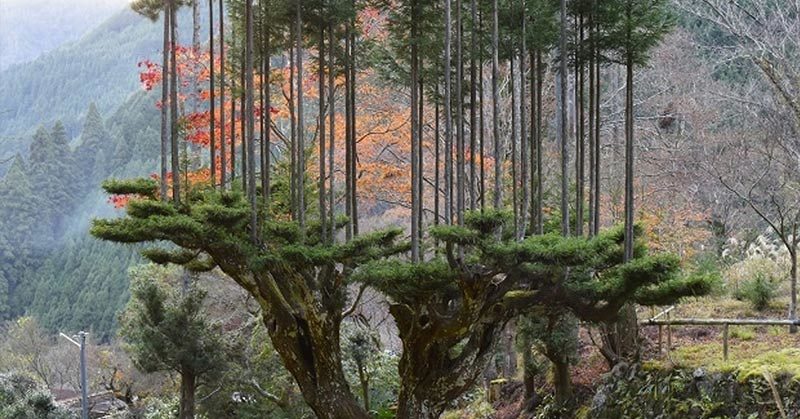You have likely heard the term “bonsai”, which is a Japanese term that, when literally translated, means “planted in a container”. It is a horticultural technique that creates miniature versions of regularly-sized trees for ornamental purposes [1]. There is, however, another similar technique used in Japan that is much less-commonly known around the world. Daisugi uses many of the same principles as bonsai, but the results are very different. Instead of tiny ornamental plants, you get lumber that is stronger, more flexible and reduces the need to cut down other trees.
Daisugi
Daisugi is a Japanese forestry technique in which specially-planted cedar trees are heavily pruned to produce “shoots” that eventually become perfectly union, straight, knot-free lumber [2].
This is an ancient method developed in the fourteenth century that was originally used by the people living in the region of Kitayama because there was a shortage of saplings. The terrain in the region is very mountainous, and the steep slopes make planting and tending to trees very difficult, so arborists used daisugi to not only reduce the number of plantations, but to produce denser wood in a much shorter time frame as well.
Harvesting these shoots takes only twenty years (much quicker than the time it takes to grow a mature tree), and one old “tree stock” can grow up to one hundred shoots at a time.
The other reason the technique was developed was because of fashion. In the fourteenth century, a form of very straight, stylized architecture known as sukiya-zukuri was extremely popular, and every prominent samurai or noble desired a home built in this way. There were not enough raw materials available to keep up with demand, so daisugi was developed to produce more lumber in a shorter amount of time [2].
Read: Spectacular Cannabis Bonsai Trees And How To Grow Them
Daisugi: Sustainable, Durable
Not only could this lumber be produce in record-time, but it was also more flexible and durable than regular wood. Lumber produced in this way is 140 percent as flexible as standard cedar, and 200 percent as dense and strong. This was especially important for homes being built in Japan, where typhoons are a common occurrence [2].
The other benefit to this method is that it is sustainable. Instead of clear-cutting massive swaths of forests, only the shoots are cut down. Since it only takes about twenty years for new shoots to grow, these specialized trees can keep up with the demand for lumber in a way that regular forestry cannot, and is much less harmful to the environment.
Ornamental Usage
By the sixteenth century, demand for lumber dropped off, but there was still a demand for the peculiar looking trees. Because of their intriguing appearance, many people across the country wanted them as ornamental plants in their gardens, and so this trend kept the practice alive.
Twitter user “The Wrath of Gnon” describes the beauty that has been left behind by this ancient practice:
“Here and there in the forests around Kyoto you will find abandoned giant daisugi (they only produce lumber for 200-300 years before being worn out), still alive, some with trunk diameters of over 15 meters. Out of this world beautiful.” [3]
Read: How Rwanda Became One of the Cleanest Nations on Earth
A Technique Unique to Japan
“The Wrath of Gnon”’s tweets have now been shared thousands of times, with many people marveling at the beauty and ingenuity of the daisugi technique. Some fellow twitter users chimed in to point out that the technique is also used in other parts of the world, such as the UK, but under the name Coppice and Pollarding.
Wrath quickly corrected them, however, admitting that while the technique is similar, it is not exactly the same because daisugi only works with saplings from one specific mutant cedar in a precise location in Kyoto [3].
So while we will not be able to use daisugi in North America, it is yet another example of the ingenuity that has come from Japan over the centuries- a small country with brilliant, hard-working, and innovative citizens finding creative solutions to problems that many others would never think of.
Keep Reading: China is Turning the Rainforest into Cheap Furniture for the US

